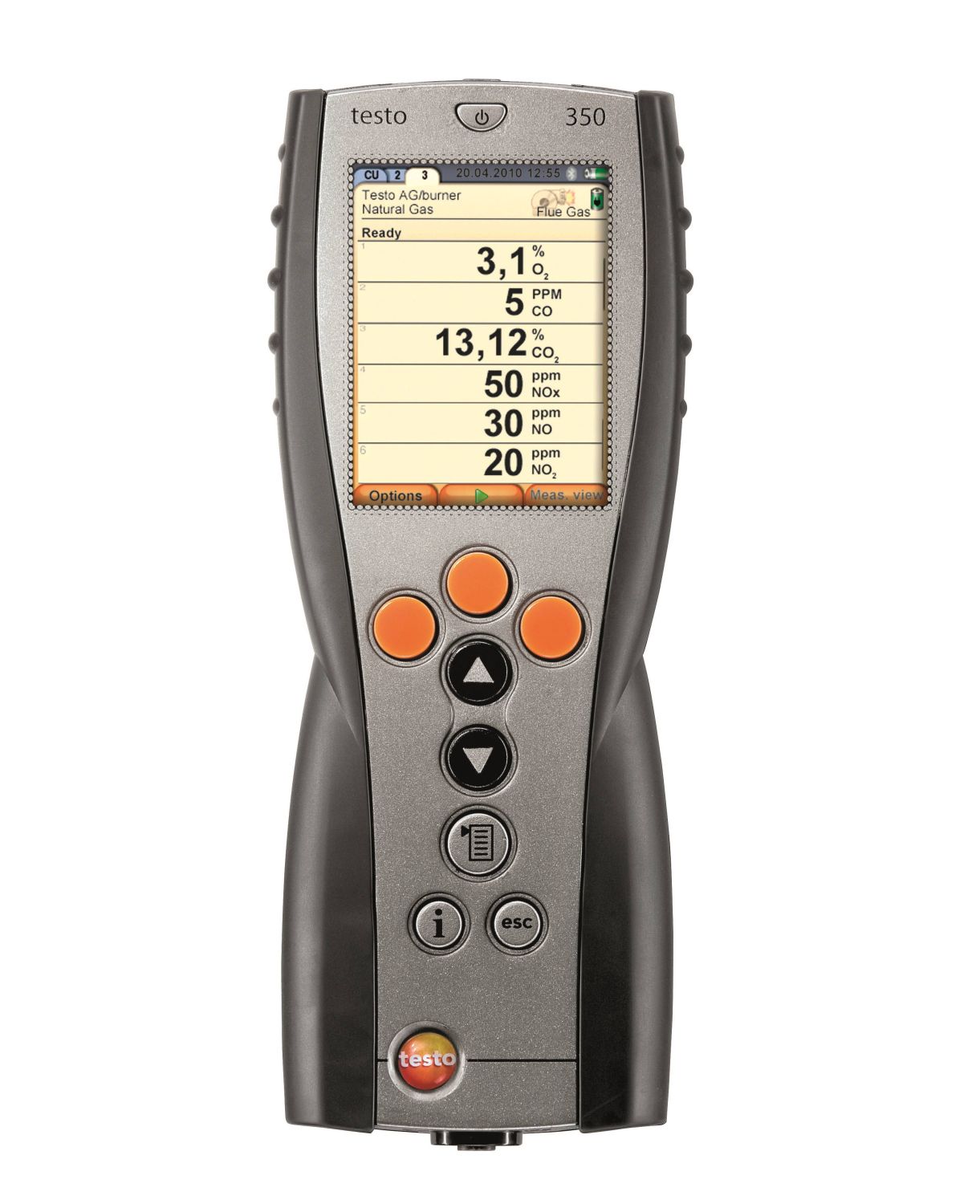Testo 350 - Control Unit for exhaust gas analyzer
Special Price 0.00
Overview
Testo 350 Control Unit is a rugged, easy-to-use exhaust gas analyzer designed to meet the highest demands when it comes to carrying out precise industrial emission measurements and providing proper data administration. The Control Unit complements the testo 350 Analysis Box (separate product) for emission measurements.
- User-friendly application-specific menu guide
- testo 350 Analysis Box can be remote controlled by the Control Unit even if not positioned at measurement site
- Internal memory for receiving measurement data from the Analysis Box
- Large graphic colour display, robust, industrial-type housing
Product Description
Ideal for professional exhaust gas analysis and industrial emission measurement. The testo 350 exhaust gas analyzer is a rugged piece of kit designed to meet the demands of a variety of different measuring and analysis applications. It is also well suited for complex data compilation.
testo 350 exhaust gas analyzer is made up of two separate units:- testo 350 Control Unit is used to monitor emission measurement. It has a clearly structured graphic display and is especially easy to use. There are four different applications in the menu to choose from: burner, gas turbine, motors and user-defined applications. The instructions on the display guide you through the measurement and make the steps leading up to the start of the measurement easier. This saves both time and hassle. The Control Unit can also be used to remote control the Analysis Box when it is not positioned at the exhaust gas pipe or measurement site. This is especially advisable when carrying out work on larger systems.
- testo 350 Analysis Box (separate product) contains the sensor system and the electronics that are needed to perform emission measurement. The Analysis Box comes standard equipped with an O2 gas sensor. You will, however, need to connect at least one more sensor (max. zix) to operate the box. Optional sensors include gas sensors for CO, CO2, NO, NO2, SO2, H2S and CxHy.
The increased measuring range allows you to carry out unlimited measurements even when gas concentrations are high. The increased measurement range (thinning) is automatically activated when gas concentrations are unexpectedly high. The measuring range of a selected sensor can be increased by a certain factor. An opening on the underside of the analyzer gives you access to all the relevant service and wearing parts, i.e. pumps and filters, which can easily be cleaned or replaced. The testo 350 also has numerous diagnosis functions with easy-to-understand readings and information. The exhaust gas analyzer constantly displays the current reading.
The Analysis Box can be controlled by the Control Unit. It can, however, also be operated directly via USB, Bluetooth® 2.0 or CANCase from a PC or notebook. After the Analysis Box has been programmed, it can carry out measurements independently and save the results. It can also transfer the data directly to the Control Unit.
Industrial emission measurement with testo 350 Exhaust Gas AnalyzerTesto 350 exhaust gas analyzer has been specially designed for carrying out industrial emission measurement in the field. In the tab “Applications” you will find out more about:
- Emission measurement on industrial engines- Emission measurement on burners
- Emission measurement on gas turbines
- Emission measurement on thermo processes
Delivery Scope
testo 350 Control Unit, rechargeable battery, data memory, USB interface, testo data bus port
| General technical data | |
|---|---|
| Dimensions | 88 x 38 x 220 mm |
| Operating temperature | -5 to +45 °C |
| Housing | ABS |
| Protection class | IP40 |
| Warranty | 2 years |
| Battery type | lithium batteries |
| Battery life | 5 h (without wireless connection) |
| Display size | 240 x 320 pixels |
| Display function | Colour graphic display |
| Maximum | 2 MB (250,000 meas. values) |
| Storage temperature | -20 to +50 °C |
| Weight | 440 g |
Service measurement on gas turbines
Gas turbines are subject to flue gas limit values which are to be adhered to during operation and regularly checked depending on the size of the system. After commissioning and maintenance work, the system's emission values are checked for adherence to limit values and also the manufacturer's specifications, and documented if necessary.
Due to the low NO concentrations, emission measurements during inspection and adjustment work on LowNOx gas turbines need to be extremely accurate. The portable flue gas analyzer testo 350 featuring the combination of NO2 sensor and special NOlow sensor with a resolution of 0.1 ppm enables precisely these requirements to be met. In addition, the integrated gas preparation and special flue gas probe with patented special hose provide protection against NO2 absorption and allow measured values to be compared, irrespective of date and ambient conditions.
Service measurement on industrial engines
The flue (exhaust) gas analyzer testo 350 is an important tool for adjusting a gas or diesel engine to optimum effect. The testo 350 is used, for example, during commissioning, at regular maintenance intervals, or for troubleshooting unstable operational processes. Exhaust gas measurement is necessary to adjust the engine to optimum operating parameters while complying with the limit value regulations in force - this often entails measurements being taken over several hours. In particular, the high and fluctuating proportion of NO2 in the engine exhaust gas makes the separate measurement of NO and NO2 necessary to provide a highly accurate indication of the real NOx value of the engine. The integrated gas preparation and the special exhaust gas probe for industrial engines with patented special hose provide protection against NO2 and SO2 absorption and allow measured values to be compared, irrespective of date and ambient conditions.
Service measurement on after treatment systems
Restrictive limit values necessitate the use of a portable flue/exhaust gas analyzer to reliably determine the exhaust gas parameters in front of and after the after treatment system. In addition to the regular inspections for mechanical damage and contamination, the flue gas measurement provides information about the efficiency and functional reliability of a system. The bus function of the flue gas analyzer testo 350 allows flue/exhaust gas to be measured simultaneously in front of and after an exhaust after treatment system; this enables fast and easy assessment of the system. Any system modifications can be obtained from the measurement protocol.
Analysis of the gas atmosphere (thermal processes)
The flue gas analysis is used for thermal process monitoring in process combustion systems, such as in continuous furnaces for the glass, ceramics and construction material sector, or in steel melting and hardening furnaces, etc. In processes of this kind, substances may pass from the product being processed into the flue gas, increasing the usual emissions produced by the combustion system;
vice versa, pollutants may pass from the gas and become part of the product being processed. The flue gas analyzer testo 350 can be used to pursue two main goals: monitoring of the process-related gas atmosphere to ensure the optimum quality of the processed products. The gas analysis provides information for process-related measures, such as the design of the furnace interior, flame control, fired product and furnace temperature, or the combustion air supply. At the same time, the gas analysis contributes to optimum operation of the system in terms of operating costs and safety.
Service measurement on industrial burners
For whichever purpose combustion systems are used, whether for heating, generating electrical power, steam or hot water, for the production or surface treatment of certain materials, or to incinerate waste and scrap materials, the best possible way of managing combustion and incineration definitely includes the right knowledge about the compositions of fuels and combustion air, and their relationship to one another. Even how they are combined is crucial. Mobile measuring technology allows all relevant gases to be analyzed and optimum combustion processes therefore to be achieved.
The purpose of using a portable flue gas analyzer is to test the environmentally sound operation of combustion systems and optimum utilisation of the system. This means that a combustion system can be adjusted to its optimum working range to enable it to meet or come within stipulated emission limit values, while achieving a maximum level of efficiency in terms of combustion. The accurate flue gas analyzer testo 350, suited to tough practical conditions, is not only used for commissioning purposes, but also for repeat gas analyses during operation.
Official emissions measurement (compliance testing)
In most countries, operation of all types of industrial plants (e.g. large power stations, steelworks. cement works, glass works, and chemical plants), and local authority facilities, right through to small production sites is subject to strict regulations governing exhaust gas emissions into the atmosphere. Suitable measures are be taken to ensure and regularly verify that the components defined as pollutants do not exceed certain limit values in the flue gas.
The flue gas analyzer testo 350 can be used to carry out a preliminary analysis before an official emissions reading, or, depending on the country and directive, the actual official compliance testing.


















